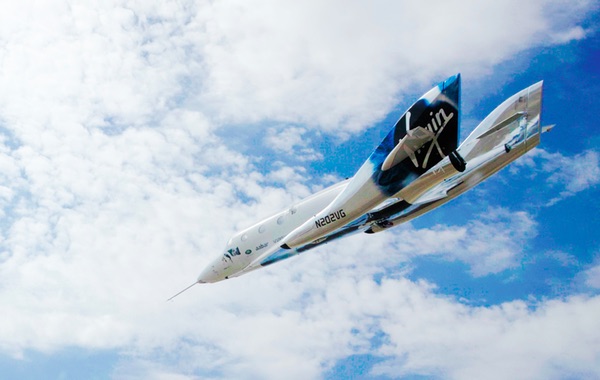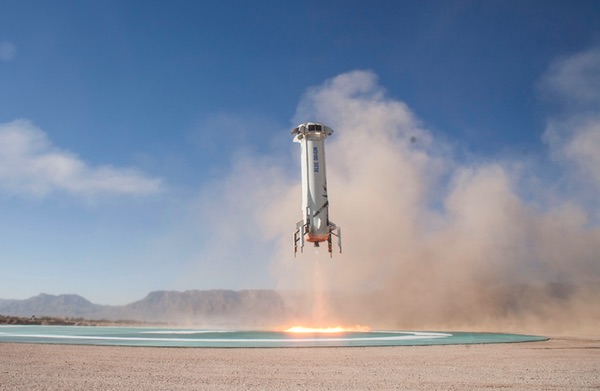2018 may (almost) be the year for commercial human suborbital spaceflightby Jeff Foust
|
| “We’re about roughly a year out from human flights, depending on how the test program goes,” Blue Origin’s Ashby said. |
Perhaps now, though, such claims carry more weight. With both Blue Origin and Virgin Galactic making progress—if at times slow and uneven—on their vehicles, there’s optimism that the days of commercial human suborbital spaceflight may be soon at hand. For those interested in flying experiments, those days have already arrived.
Blue’s latest leap
The latest evidence of suborbital progress came December 12, when Blue Origin resumed test flights of its New Shepard suborbital vehicle. The successful flight, from the company’s test site in West Texas, was the first time that the vehicle flew since October 2016, and the first for a new version of both the vehicle’s propulsion module and crew capsule.
That gap in test flights was a pause to incorporate the lessons learned from the flights of the earlier version of the vehicle, a company executive explained. “We learned a lot from it, which is why you saw a one-year hiatus before we began flying again,” said Jeff Ashby, director of safety and mission assurance at Blue Origin, during a presentation at the Next-Generation Suborbital Researchers Conference (NSRC) December 18 in Broomfield, Colorado.
“We had to incorporate the learning that we had done. How do you make this more reliable? How do you make this booster and capsule human-capable?” he explained. “That’s what we’ve been doing for the last couple of years.”
More test flights are planned for 2018 that, like December’s flight, will be done without people on board. Ashby said the first flights with people on board are about one year away.
“We’re about roughly a year out from human flights, depending on how the test program goes,” he said. “We have a bunch more tests to do, and we’re going to fly some human test flights before we put paying people in the rocket.”
In a later panel discussion at the conference, Ashby said he did not think that the series of test flights with people on board would take very long. “There will be a human test program to verify the human interface before we fly commercial passengers,” he said. “How long that will be we haven’t baselined yet. It’s not going to be more than a few months at most, unless we find some real surprises.”
“I’m guessing,” he added, “most of the surprises we’d find would be good ones.”
 Virgin Galactic’s second SpaceShipTwo, VSS Unity, during its most recent glide flight in early August 2017. (credit: Virgin Galactic) |
Virgin’s slow progress
Virgin Galactic, too, has talked about flying people into space on its SpaceShipTwo suborbital spaceplane within the next year. On more than one occasion, company founder Sir Richard Branson has said he would be disappointed if he—a participant on the first commercial flight of the vehicle—doesn’t get to space by the end of 2018.
| “We’re looking forward to having a full 2018 with powered test flights,” Virgin Galactic’s Whitesides said. “That will be a very exciting phase for our company. We’re going to take our time to do it right.” |
However, there’s be little in the way of visible test progress with the second SpaceShipTwo, named VSS Unity. The vehicle’s last glide flight was in early August, and powered test flights of the vehicle have yet to begin despite previous suggestions by company officials that they would start by the end of 2017.
“We’ve been doing a lot of work on the vehicle to be prepared for that phase of flight,” Virgin Galactic CEO George Whitesides said at the conference of the upcoming powered test flight campaign. “We’re looking forward to having a full 2018 with powered test flights. That will be a very exciting phase for our company. We’re going to take our time to do it right.”
Whitesides confirmed previous statements that one more glide flight is planned before those powered test flights start. “There will be a lot of different test points that we’ll need to get through and evaluate the ship as we incrementally get to space and, once we’ve done that, to refine the various aspects of the customer experience, including the interior and other things like that,” he said.
The biggest recent milestone for Virgin Galactic has been financial, not technical. In October, the Virgin Group announced an agreement with the government-backed Public Investment Fund (PIF) of Saudi Arabia to invest $1 billion in Virgin’s space portfolio, including Virgin Galactic, orbital launch provider Virgin Orbit, and SpaceShipTwo manufacturer The Spaceship Company. The agreement included an option for an additional $480 million in financing for the companies.
At the time of the announcement, the agreement was still in the form of a non-binding memorandum of understanding, with no details about how the funding would be apportioned among the companies and for what purposes. Whitesides didn’t offer any new details about the funding at the conference.
“We’re working through the partnership with PIF. We’re very excited about that partnership,” he said. “We’ll announce more as we’re ready to do so.”
Research flights, and with people
While both companies may still be a year or more from flying people commercially, both are looking ahead to doing so not only for tourism, but also in support of research.
For Blue Origin, the December test flight was a key step in that effort. Besides testing vehicles similar to those planned for commercial human flights, it was the first New Shepard mission to fly under an FAA launch license. Previous test flights took place using an experimental permit, which prohibits the use of the vehicle for revenue-generating flights.
“This was our first commercial flight, which in many ways was the flight that I had been waiting for since my first NSRC,” said Erika Wagner, business development manager at Blue Origin, said during a panel discussion later at the conference. “We had paying customers on board, both NASA and commercial.”
Blue Origin will continue to carry research payloads on future test flights of the vehicle. Wagner said the manifest for 2018 is largely full now, although the company said not disclosed a schedule of flights of the vehicle.
Once in regular commercial service, flights could carry a mix of experiments and payload specialists to oversee them. Ashby said at the conference that the company was about a year and a half to two years away from being ready to fly “human-tended” payloads.
Virgin Galactic also plans to carry research payloads, which would be overseen in many cases by a company payload specialist. At the conference, Virgin Galactic announced an agreement with the Italian Space Agency to fly a dedicated research flight, which would include an Italian payload specialist.
“I think this is an important example of a government space agency contracting with a commercial space company to conduct human-tended suborbital research,” Whitesides said. That flight is currently scheduled for 2019.
| “Moving forward, as these capabilities start coming online, we’ll figure it out,” Jurczyk said of NASA support for human-tended payloads on commercial suborbital vehicles. |
Some at the conference wondered when NASA might follow suit. The agency’s Flight Opportunities program currently buys flights on suborbital vehicles, including New Shepard and SpaceShipTwo. However, the program has long prohibited NASA-funded researchers from being able to fly with their experiments.
The agency opened the door to human-tended payloads in 2013. Speaking at the NSRC in June of that year, NASA deputy administrator Lori Garver announced that the prohibition would be lifted. However, the agency has yet to formally enact that policy, in part because Garver, who pushed for it, left NASA months later, as well as extended delays in the development of vehicles like New Shepard and SpaceShipTwo.
“It mostly resulted in a bunch of ostriches sticking heads in the sand for a few years,” Wagner said. However, she said that’s changing as vehicles get closer to commercial service. “The heads are back out. They’re looking around trying to understand what really are the barriers, what is the liability regime.”
At the conference, Steve Jurczyk, NASA associate administrator for space technology, said the agency would now be more open to funding human-tended payloads. “Moving forward, as these capabilities start coming online, we’ll figure it out,” he said.
He suggested that NASA could put into place a process it currently uses for parabolic aircraft flights by Zero G, which also carries experiments for the Flight Opportunities program. NASA-funded researchers can fly with their experiments on those flights, he said, as NASA’s Armstrong Flight Research Center evaluates those flights in addition to the existing regulatory oversight by the FAA. (That does not extend to NASA civil servants, he said, because of NASA policy against having employees sign liability waivers for such flights.)
“It just ensures that our grantees and contractors are safe to fly, and then we allow them to go fly,” he said. “We’ve tailored the process so that we do what’s right, but it’s not overly burdensome.”
The interest in flying experiments on suborbital vehicles, and flying with those experiments, remains strong despite years of delays in the development of those vehicles. “I think because the vehicles are now coming online, and experiments are starting to fly, we see a really vibrant environment,” said Alan Stern of the Southwest Research Institute, organizer of the conference, which dates back to 2010.
At a press conference during the meeting, he expressed optimism that those vehicles will be flying soon, and that research uses of them will lead the way. “We’ve gone from models of vehicles to actual vehicles in flight test or ready to flight test,” he said. “2018 and 2019 are going to be landmark years.”
“It is starting off as a tourism business,” he added, “but it is primarily a research, education and commercial applications business that’s out there leading the applications.”
